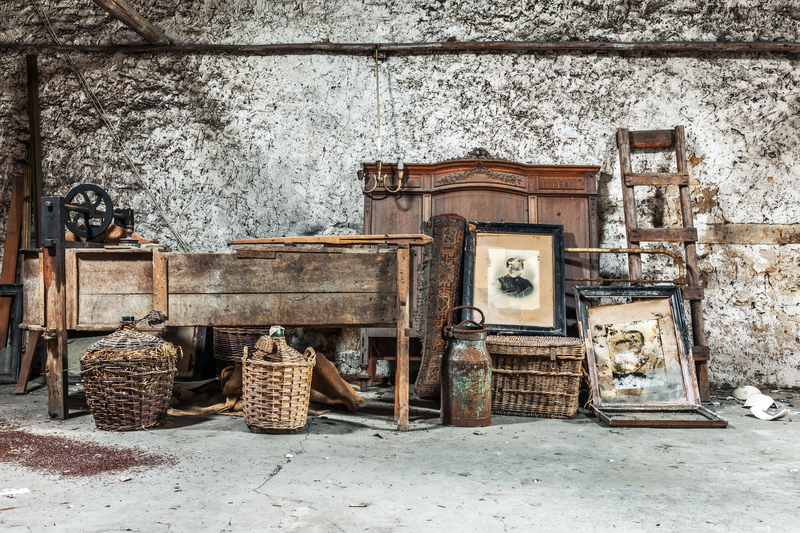A Comprehensive Guide to Packing Like a Pro for Moving
Posted on 18/05/2025
A Comprehensive Guide to Packing Like a Pro for Moving
Moving can be an overwhelming process, but with the right strategy, you can turn a daunting task into an organized, stress-free experience. Whether relocating across town or going cross-country, understanding how to pack efficiently is crucial. In this comprehensive guide to packing like a pro for moving, you'll find actionable tips, expert packing strategies, and practical checklists to ensure that every item makes it safely to your new home.
Why Packing Efficiently for Moving Is Important
Packing smart doesn't just save time. It prevents damage to your belongings, minimizes moving costs, and helps create a smoother transition into your new space. Inefficient packing often leads to misplaced items, broken valuables, and higher stress levels on moving day. By learning how to pack like a professional, you can avoid these common pitfalls.
Key Benefits of Packing Like a Pro
- Reduced Risk of Damage: Proper packing materials and methods protect your possessions.
- Greater Efficiency: Smart packing streamlines both loading and unpacking.
- Lower Costs: Organized packing can mean fewer boxes, less material, and reduced labor time.
- Peace of Mind: Knowing everything is organized helps you stay calm throughout your move.

Essential Packing Supplies for Moving
Before diving into boxing up your items, make sure you have all the essential packing supplies for moving. Using the right materials is the foundation of professional packing. Here's what you'll need:
- Sturdy Moving Boxes: A variety of box sizes (small, medium, large, wardrobe boxes)
- Packing Tape: Heavy-duty packing tape to secure boxes
- Packing Paper: For wrapping fragile items and filling empty spaces
- Bubble Wrap: Adds extra protection for breakables
- Markers and Labels: For clear, effective labeling and inventory management
- Plastic Bins: Ideal for storing heavy items or things you'll need right away
- Scissors and Box Cutters: For opening and securing boxes
- Stretch Wrap: Keeps furniture drawers and doors closed, and bundles awkward items together
- Furniture Pads or Blankets: Prevents scratches and dents on large, heavy items
- Gloves: Protects your hands during the packing process
Packing Like a Pro: A Room-by-Room Guide
The secret behind expert movers is strategy: packing one room at a time, labeling everything carefully, and securing items based on their fragility. Let's break down the best practices for each part of your home:
1. The Kitchen: Efficient Packing Strategies
- Declutter First: Dispose of expired foods and donate kitchen gadgets you no longer use.
- Pack Plates Vertically: Wrap each plate in packing paper and place them vertically in sturdy boxes, just like records, to prevent breakage.
- Use Original Boxes for Appliances: If available, use original packaging for small appliances. Otherwise, wrap them carefully with bubble wrap and secure any loose parts.
- Essentials Box: Pack a separate box with utensils, plates, a pot, and cleaning supplies you'll need immediately upon arrival.
- Label Fragile Items: Mark all boxes containing glass, ceramics, or electronics as fragile and indicate which side should face up.
2. Living Room: Protecting Your Electronics and Decor
- Televisions and Screens: Use dedicated or wrap screens with blankets and bubble wrap. Never pack anything on top of electronics.
- Cushions and Pillows: Pack soft items in large plastic bags, which can also provide cushioning to fill empty box spaces.
- Books: Use small boxes for books to keep the weight manageable. Lay flat or pack spine-down to prevent damage to the bindings.
- Photo Frames and Artwork: Wrap individually, use corner protectors, and place upright in boxes.
3. Bedroom: Clothing, Bedding, and Personal Items
- Wardrobe Boxes: Invest in wardrobe boxes to keep clothes on hangers. This saves time ironing later.
- Vacuum Seal Bags: For off-season clothing or bulky bedding, use vacuum-sealed bags to save space.
- Pack a First Night Bag: Include sleep essentials, toiletries, and a change of clothes for each family member.
- Jewelry and Valuables: Pack separately and keep with you during the move.
4. Bathroom: Packing Toiletries and Medicine
- Leak-Proof: Use zip-top bags for liquids and bottles to avoid messy spills.
- Sort and Purge: Dispose of expired medications and used toiletries.
- Easy Access: Pack a small container with the bathroom toiletries you'll need right away--keep this in your essentials box.
5. Garage or Storage Areas: Tools and Sports Equipment
- Tools: Remove all fuel from lawn mowers, weed trimmers, etc. Bundle small hand tools in toolboxes or roll in towels for safety.
- Sports Equipment: Disassemble large items if possible. Use original bags for golf clubs, helmets, or rackets.
- Hazardous Materials: Properly dispose of paint, gasoline, and other chemicals. Many moving companies will not transport these items.
Expert Packing Tips: How to Pack Like a Moving Professional
Beyond room-by-room packing, veterans of the moving industry recommend the following universal strategies for packing like a pro for moving:
- Start Early: Begin boxing up non-essential items weeks in advance to prevent last-minute rush.
- Label Every Box: Clearly note the destination room and a brief summary of contents on each box's top and sides.
- Color-Coding: Assign a different color label for every room, making sorting easier at your new home.
- Use Small Boxes for Heavy Items: Books, dishes, and tools belong in small boxes to avoid overloading.
- Leave No Empty Space: Fill gaps in boxes with linens, towels, or packing paper to prevent shifting.
- Pack One Room at a Time: Reduces mix-ups and confusion during both packing and unpacking.
- Keep Important Documents with You: Passports, ID, financial information, and safeguard-only boxes should always stay in your personal vehicle.
- Seal Boxes Tightly: Use professional-grade packing tape--always double-tape the bottom seam for extra support.
- Photograph Electronic Set-ups: Take photos of wiring for TVs, computers, and sound systems before unplugging, making re-setup simpler.
- Don't Overpack: Even the pros say that less is more. Use multiple boxes rather than risking breakage or injury with overly heavy loads.
Moving Day Preparation: Staying Organized
When moving day arrives, preparation is key to keeping things organized and minimizing stress. Here's how to prepare like a professional:
- Have a Master Inventory: Keep a moving checklist and track every box. This helps you spot missing boxes immediately and eases unpacking.
- Protect Floors and Doorways: Lay down blankets or plastic sheeting to protect your new and old home from scuffs and dirt.
- Load the Truck Properly: Place heavy boxes on the bottom, lighter ones on top. Fill in all spaces securely to prevent movement.
- Essentials Box Up Front: Load the essentials box last, so it's the first thing you unload and have immediate access to key items.
- Communicate Clearly: If hiring movers, explain your labeling system and point out fragile boxes or items requiring special care.
Common Packing Mistakes (and How to Avoid Them)
- Underestimating Time Needed: Packing takes longer than most people expect. Start early and pack a bit every day.
- Reusing Worn-Out Boxes: Old boxes might collapse, damaging your belongings.
- Skipping Labels: Unlabeled boxes create chaos at unpacking time--never skip labeling!
- Poor Protection of Fragile Items: Always use bubble wrap, packing paper, and adequate cushioning.
- Ignoring Weight Balance: Mixing heavy and light items in the same box can crush delicate possessions.
- Failing to Pack an Overnight Bag: You'll need essentials like toiletries, charger, and change of clothes right away.
Eco-Friendly Packing Tips for Your Move
If you're looking to minimize your environmental impact while packing for a move, consider these sustainable options:
- Borrow or Rent Reusable Plastic Bins: Reduce cardboard waste.
- Reuse Household Items: Use towels, blankets, and clothing as padding for breakables.
- Recycle Old Boxes: Source boxes from local stores or friends.
- Donate Instead of Disposing: Give away items you no longer need, helping others and reducing landfill waste.
- Recycle Packing Materials Afterward: Properly recycle paper, cardboard, and plastics used during your move.
What to Unpack First in Your New Home
Once you arrive at your new place, unpacking with a plan ensures you settle in quickly. Here's what the pros suggest:
- Essentials Box: Set up toiletries, bedding, snacks, and important documents first.
- Kitchen Basics: Unload dishes, cookware, and utensils.
- Bedroom Setup: Assemble beds and make them for the first night.
- Electronics: Set up internet and key devices for guidance in unpacking or relaxing after a long day.
Should You Hire Professional Movers or DIY?
One of the biggest decisions during home relocation is whether to hire professionals or move yourself. Here are things to consider:
- Time Savings: Pros handle packing, loading, and unloading, saving you hours (or days).
- Skill and Equipment: Movers offer expertise and the right equipment, minimizing risk of damage.
- Budget: DIY packing is cheaper upfront, but be honest about the costs of supplies, truck rental, and your time.
- Fragile, Valuable, or Heavy Items: Professional movers have experience handling pianos, antiques, and artwork.
In some cases, a hybrid approach--packing yourself like a pro, but hiring movers for the heavy lifting--is the ideal compromise.

Moving Day Survival Checklist
- Confirm Details with Movers: Double-check arrival time and moving plan.
- Have Payment Ready: Most movers expect payment upon delivery.
- Keep Valuables with You: Never pack jewelry, cash, or sensitive documents in the moving truck.
- Take Photos of Your Belongings: Document items for insurance just in case.
- Do a Final Walkthrough: Check all rooms, closets, cabinets, and the garage before leaving your old home.
Conclusion: Pack Smart, Move Happy
Packing like a pro for moving isn't a secret reserved for experts. With careful planning, the right materials, and these time-tested tips, anyone can master an efficient packing process. Remember to start early, label everything, pack with protection in mind, and stay organized--these steps help guarantee a smooth, stress-free move. Whether you're handling the move yourself or enlisting professional movers, this complete guide to packing efficiently will ensure your belongings arrive at your new home safely and ready for your next adventure.
Happy moving--and may your next relocation be the easiest one yet!



